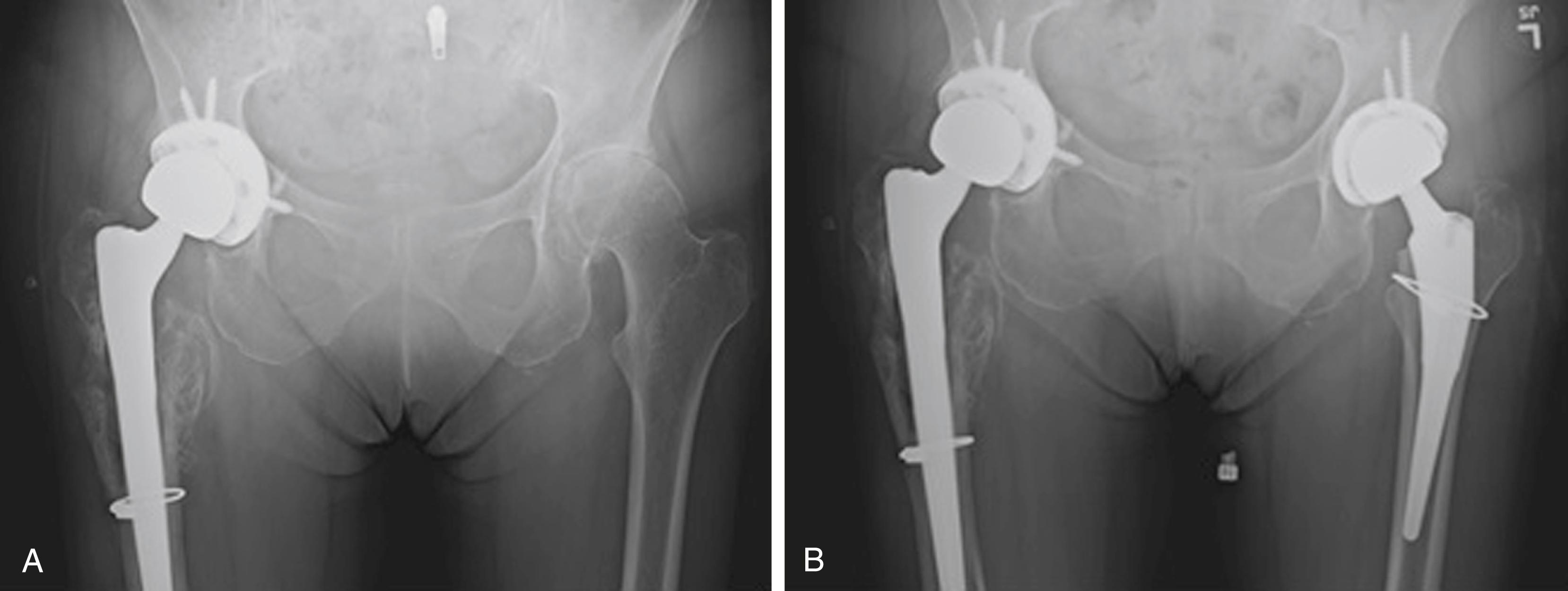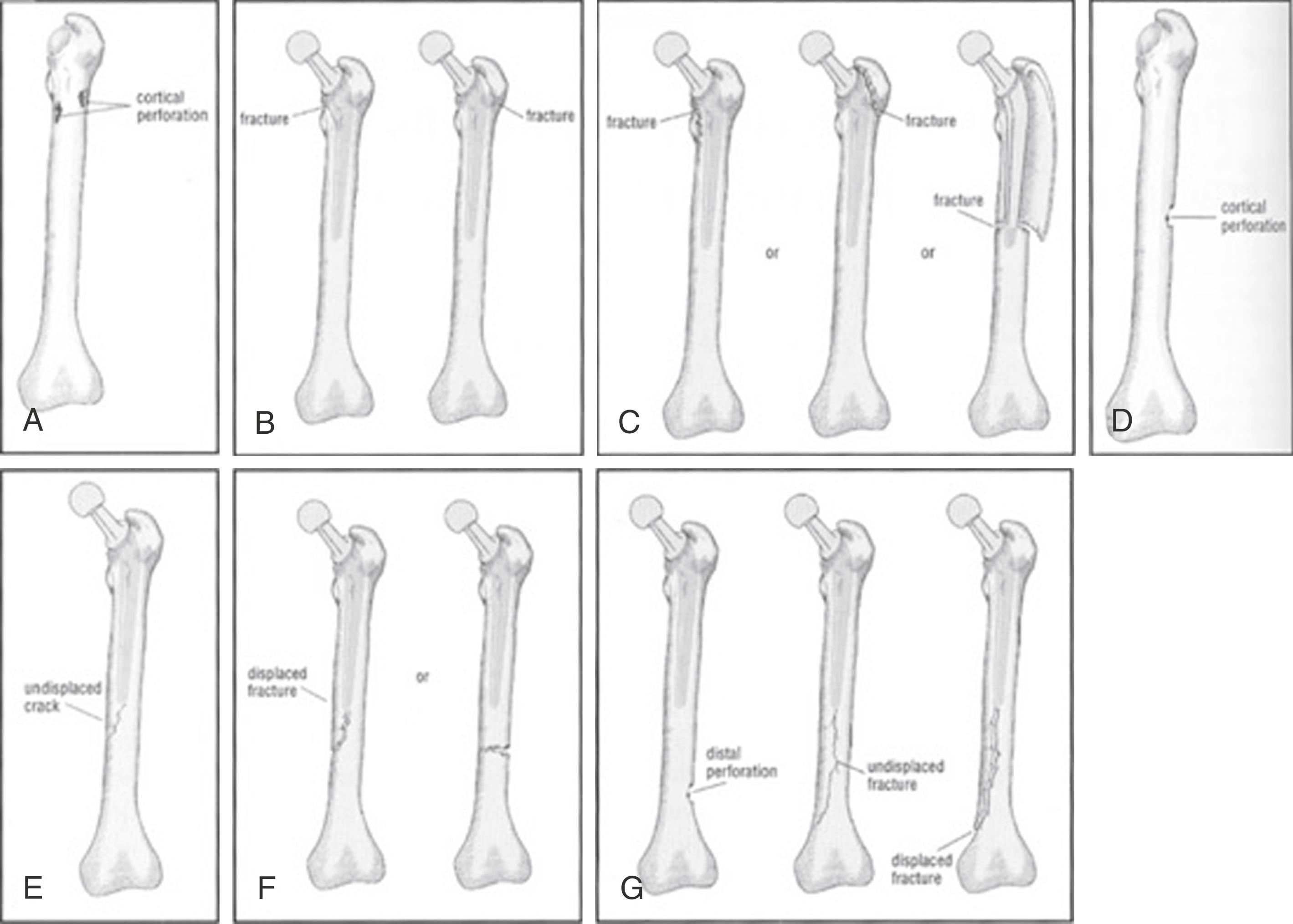Physical Address
304 North Cardinal St.
Dorchester Center, MA 02124
Periprosthetic fractures around a total hip arthroplasty (THA) can be difficult and morbid complications to treat. As the number of THA procedures performed in the United States continues to rise, the incidence of periprosthetic fractures is expected to increase concurrently. Most of the focus in the literature has been placed on postoperative periprosthetic fractures, but intraoperative fractures are not uncommon and can be challenging to treat. The most widely described risk factors for this complication include female sex, increased age, osteoporosis, and rheumatologic disease. To obtain optimal results for these patients, a thorough understanding of the clinical evaluation and treatment principles of intraoperative periprosthetic fractures is required. The classification and management of these fractures depends on the location of the fracture, the stability of the implant, and the ability to achieve stable fracture fixation. This chapter discusses how the practicing arthroplasty surgeon can utilize these principles to achieve optimal outcomes in the setting of periprosthetic fractures around THA implants.
The incidence of periprosthetic fractures during THA ranges from 0.089% to 27.8%, with a particularly high incidence in revision cases using uncemented stems. , The incidence of missed intraoperative periprosthetic fracture is difficult to discern, but it has previously been estimated that up to 40% of postoperative periprosthetic fractures were likely intraoperative fractures that were not noticed at the time. Recognizing and appropriately treating intraoperative periprosthetic fractures is critical to optimal outcomes, as these patients may require additional surgery and have longer hospital stays, poorer outcomes, higher mortality rates, and inferior clinical outcomes than patients without fractures. , The recognition and proper treatment of intraoperative periprosthetic fractures is thus critical for an optimal patient outcome, as failure to treat these in a timely manner can lead to increased morbidity for the patient and potential need for further surgery. Once diagnosed, it is critical that the fracture is adequately characterized and treated. In patients with stable implants, fracture fixation alone is performed or postoperative rehabilitation is altered to allow for fracture healing. When the implant is loose, both complex revision arthroplasty and open reduction internal fixation (ORIF) may be required to provide stability.
As with all complications in total joint arthroplasty, preoperative evaluation and planning is the best method of prevention. Several patient characteristics have been correlated with a higher incidence of intraoperative fractures; it is important that these patients are appropriately worked up prior to undergoing THA to minimize risk of adverse outcomes. The most widely described risk factors are female gender, increased age, osteoporosis, and rheumatologic disease. , , Other medical comorbidities, such as malnutrition, heart failure, hemiparesis/hemiplegia, malnutrition, and liver disease have also been discussed in the literature. However, some authors have argued that all of these variables are confounded by their association with osteoporotic or osteopenic bone. It is important for the surgeon to recognize all demographic variables and comorbidities that may be correlated with a higher incidence of poor bone quality, as these patients will likely be at a greater risk of intraoperative fracture.
Altered bone morphology, as seen in Paget disease, rickets, or posttraumatic deformity, can also lead to elevated fracture risk. Extra care should also be taken with patients who have ankylosing spondylitis or history of spinal fusion, as studies have shown that these populations are at a greater risk for periprosthetic fracture. Patients with hardware in place from prior surgeries should also be carefully evaluated, as they are likely to have morphologic abnormalities from bone remodeling and pose a higher risk of intraoperative fracture when the hardware is taken out during the case. , It is critical that full-length multiplanar radiographs are obtained in these patients prior to surgery to evaluate the shape of the femur. An in-depth preoperative plan should also be formulated to ensure that the correct implants and approach are used to minimize fracture risk as well as the correct sequence of hardware removal for those with existing implants.
While there has been growing interest in the use of the direct anterior (DA) approach to THA, little has been written about the incidence of intraoperative fracture during THA based on the approach used by the surgeon. Previous studies have indicated that the steep learning curve and use of specialized tables with mobile foot attachments during DA THA can lead to a higher risk of intraoperative fractures during the early phases of learning the technique. Studies on the DA approach have found a 0.8% rate of femoral shaft fracture and 5.7% rate of fracture of the proximal femur or greater trochanter. Other studies have noted a high incidence of cortical perforations and trochanteric fractures during the early learning phase of DA THA. , However, all of these studies noted that the incidence of these complications lessened as the surgeon became more experienced. Further study is needed on the relative incidence of intraoperative periprosthetic fractures across different approaches to hip replacement.

It is also important to note that the risk of periprosthetic fracture increases substantially in revision THA in comparison with primary THA. , This has been postulated to occur for several reasons, including the presence of osteolysis or stress shielding from the initial surgery, as well as stress risers and bone defects from prior implants. There is added risk for intraoperative fracture with use of a large diameter stem or under-reaming of the femoral cortex, particularly in patients with a low cortex-to-canal diameter ratio.
The vast majority of intraoperative fractures occurring during THA are around the femoral component. , These fractures are easier to identify than acetabular fractures. However, the treatment algorithm is arguably more complicated, with less consensus on the optimal management. The incidence of intraoperative femoral fractures has been reported as ranging from 0.3% to 27.8% and is up to 18 times more likely to occur with the use of uncemented stems. , ,
Intraoperative femoral fractures can be broadly grouped into occurring in three regions of the femur: the proximal femoral metaphysis around the trochanteric region (region A), the proximal diaphysis surrounding the stem (region B), and the distal diaphysis extending well below the stem (region C). Fractures in region A typically occur with overly aggressive bone preparation during rasping or broaching or from a dimensional mismatch during implant insertion. Region B fractures typically occur during cement removal or from increased hoop stresses during placement of either the broach or trial implants with excessive force, but can also occur from overly aggressive hip dislocation maneuvers. Region C fractures most often occur when there is a mismatch between the radius of curvature of the implant and the femur, particularly when the tip of a straight stem prosthesis impacts the femoral bow distally.
The risk factors associated most closely with intraoperative femur fractures include the use of cementless stems and patients undergoing revision THA. , , , , The combination of bone loss associated with revision THA, in conjunction with the need for long press-fit stems, results in a higher likelihood of intraoperative fractures in these patients. Issack et al. reported an 8% incidence of intraoperative femur fracture in patients undergoing revision THA with a cementless, porous coated, distally slotted, fluted stem. Another technique that has been widely associated with intraoperative fractures is femoral impaction bone grafting, which has been reported to be between 4% and 32%. Most of the fractures that occurred with this technique have been described during the cement removal portion of the procedure, although they can occur during allograft impaction as well. There has also been some discussion in the literature regarding whether minimally invasive techniques confer higher risk of intraoperative femoral fracture, particularly the limited incision direct lateral and direct anterior approaches. , To date, these studies have provided inconclusive evidence that minimally invasive surgery increases the risk of intraoperative fracture, and further study is needed on this topic.
Diagnosis of an intraoperative femur fracture can be difficult due to the sometimes subtle nature of presentation. Typically, the surgeon experiences a sudden change in resistance during insertion of the component, particularly when using a cementless stem, or an inability to maintain stable stem placement after insertion. , , In these circumstances, the surgeon must have a high index of suspicion for a femur fracture and should immediately obtain intraoperative radiographs to evaluate for fractures. It is important to note that nondisplaced fractures may not always be visible, particularly on fluoroscopic imaging. Thus, clinical assessment and imaging findings must be used concurrently to evaluate the patient. , ,
Once it has been ascertained that a fracture has occurred, the surgeon should classify it fully to decide the appropriate treatment. The most widely used system to describe and dictate treatment of these fractures is the Vancouver Classification, originally described by Masri and colleagues ( Figure 21.1 ). This classification considers both the location and pattern of the fracture to determine its stability and, therefore, its optimal treatment strategy. The location of the fracture follows the same regional locations of the femur as discussed earlier, namely:
Type A—Proximal metaphysis
Type B—Diaphysis
Type C—Distal to the stem tip and not amenable to insertion of the longest revision stem

Next, the fracture subtype is assessed as follows:
Type 1—Simple cortical perforation
Type 2—Nondisplaced crack
Type 3—Displaced unstable fracture
Although the nuances of treatment for these fracture types may be debated, the key tenets of treatment based on the fracture pattern are well established. The overarching principles include maintaining components in a stable, well-aligned position while also obtaining control of the fracture and avoiding further propagation. , For most fractures, this entails removal of implants, stabilization of the fracture with cables and/or cortical allograft, and reinsertion of a stem that is long enough to bypass the defect by two cortical diameters. , , Proximal fractures are typically easier to treat as they can easily be bypassed with the stem or treated with cabling, whereas more distal fractures require more extensive exposure and treatment measures.
The most common fracture patterns are discussed next, together with the author’s preferred method for their fixation.
Become a Clinical Tree membership for Full access and enjoy Unlimited articles
If you are a member. Log in here